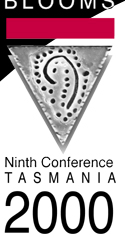 |
Abstracts:
Noctiluca scintillans — An
indicator of coastal eutrophication?
|
Jocelyn Dela-Cruz1,
Penelope Ajani 2, Randall Lee 2 and Iain
Suthers 1
1School of Biological Sciences,
University of New South Wales, Sydney, N. S. W., 2052, Australia 2
Water Science Section, Environment Protection Authority, New South
Wales, Locked Bag 1502, Bankstown, N.S.W., 2200, Australia
|
Noctiluca scintillans ,a large
heterotrophic dinoflagellate, has been present in New South Wales
coastal waters since 1860. Noctiluca was a minor component of the
phytoplankton up until the last decade, but since then, Noctiluca
blooms appear to have increased in frequency and intensity, with the
majority of blooms recorded in recent years. There has been public
concern that this increase in Noctiluca blooms may be a result of
chronic sewage discharge from three deepwater ocean outfalls in the
coastal waters surrounding Sydney. Such concern is consistent with the
debate that Noctiluca maybe a coastal eutrophication indicator
species. Over a one year period (1997-1998) at a long-term monitoring
station off Sydney, Noctiluca was present year round with peak
abundances coinciding with episodic slope water intrusions (and
subsequent upwelling) during spring and summer. Extensive red tides of Noctiluca
often succeeded diatom blooms (specifically Thalassiosira spp.)
which were initiated by these intrusions. 80-90% of Noctiluca
cells contained food particles and there was a positive linear
relationship between abundance and the proportion of cells containing
food. Prevalent food items within the vacuoles of Noctiluca were
diatoms. Water samples collected north of Sydney also showed that
highest numbers of Noctiluca occurred in areas predisposed to upwelling.
Upwelling is likely to be the mechanism that promotes population growth
of Noctiluca along the coast of N.S.W. Despite these findings, it
is still difficult to disregard the direct or indirect effects of
anthropogenic nutrients on the growth of Noctiluca. A long term
assessment of physico-chemical dynamics in the water column off Sydney
showed that there was no real change in phytoplankton biomass nor in
uplifting/upwelling frequency in the last decade, yet the recent year
round presence of Noctiluca is unprecedented for this region. A
shift in the dominant diatom genera to Thalassiosira (believed to
be the optimal food source of Noctiluca) concomitant with a rise
in temperature and reduction in nitrate and phosphate levels may be the
cause for the increase in Noctiluca numbers during this sampling
year. The presence of a strong ENSO signal in 1997-1998 was shown in
companion studies to dominate physico-chemical conditions, and thereby
mask any anthropogenic effects. Future investigations need to
incorporate this influence to resolve and partition climatic and
anthropogenic signals.
Abstracts:
Sedimentological evidence of an increase in
Pseudo-nitzschia (Bacillariophyceae) abundance in response to
coastal eutrophication
|
Michael L. Parsons 1 &
Quay Dortch 2
1Marine Science Department, Natural
Sciences Division, University of Hawai\'i-Hilo, 200 W. Kawili
Street, Hilo, Hawaii, USA 96720 2Louisiana Universities
Marine Consortium, 8124 Hwy. 56, Chauvin, Louisiana, USA
70344 |
Pseudo-nitzschia abundance is extremely high in
the northern Gulf of Mexico in the plume of the Mississippi River,
especially when river flow and nutrient inputs are high. Five sediment
cores were collected to determine if, and to what extent,
Pseudo-nitzschia valves preserved in the sediment in order to
reconstruct changes in Pseudo-nitzschia abundance in the past
century. Pseudo-nitzschia increased in relative and absolute
abundance in all five sediment cores, most markedly in the sediment layers
corresponding to the time period between the 1950s and 1970s as determined
by lead-210 sedimentation rate estimates. Previous research has
demonstrated that a dramatic increase of fertilizer use in the United
States occurred at this time, which has resulted in the development of
eutrophication and hypoxia in the coastal waters of the northern Gulf of
Mexico. Scanning electron microscope analysis of the fine structure of
Pseudo-nitzschia and other lightly-silicified diatom valves
preserved in the sediment indicates that the increase in
Pseudo-nitzschia abundance appears to reflect a response to
eutrophication rather than valve dissolution processes. This study
provides evidence for a direct link between coastal eutrophication and
harmful algal blooms.
Abstracts:
On the long-term response of harmful algal blooms
to the evolution of eutrophication off the Bulgarian Black sea coast: Are
the recent changes a sign of recovery of the ecosystem? — The
uncertainties
|
Snejana Moncheva, Institute of
Oceanology, BAS, Varna, 9000, P.O. Box 152, Bulgaria
Based on the level of eutrophication of the
Black sea coastal ecosystem the 1954 - 1998 period could be
subdivided into: a relatively pristine period (60-70ies), a period
of an intensive anthropogenic pressure (the 80-ies), and the
90-ies a period of relaxation, related to the collapsing economy
and agricultural production and the concurrent reduction of the
land-based nutrients load to the basin. In the present paper the
long-term trends (1954-1998) of phytoplankton blooms (species
involved, frequency and timing) are discussed in relation to the
evolution of anthropogenic eutrophication and the variability of
temperature, sun activity and total zooplankton biomass. The main
peculiarities of the current period - an increase in the diversity
of red-tide species; a shift in their taxonomic composition, a
decrease of blooms frequency and maximum densities attained; a
reduction of summer blooms on the account of an increase in
winter-spring and autumn events, coincide well with the decrease
of nutrients level and the shift of their ratios especially in
summer. The MDS plot of phytoplankton blooms and the environmental
matrix reveal similar clustering discriminating between
70ies-90ies and 80ies, the 90-ies being more close to the 70-ies.
The results suggest that the recent changes of phytoplankton
blooms could be considered a sign of recovery as a response to the
relative improvement of the chemical parameters of the coastal
zone. The main uncertainties are still the maintained capacity of
the ecosystem to produce high biomass, the concerted environmental
changes and similar alterations reported for other regions of the
World Ocean, suggesting a possible global climatic signal of
influence too.
|
| Conference
Overview | Abstracts
by Title | Abstracts
by Author |
For more information, please contact the conference
secretariat:

Conference Design Pty. Ltd., PO Box 342, Sandy Bay, Tasmania, Australia
7006.
Telephone: +61 3 6224 3773.
Fax: +61 3 6224 3774.
Email: mail@cdesign.com.au.
| abstracts
| registration
| location
| programme
| submissions
| general
information | |

